Arts and Crafts Kit Trendy in the 1970s Crossword Clue
Given the anarchy and incertitude wrought past the COVID-19 pandemic, trying to pin down the summit fashion and beauty trends of a year hence feels as futile as trying to pick a living room wallpaper pattern while your firm is on burn down. Only nosotros tried anyway by surveying a range of L.A.-based designers, brand builders and retailers to observe out what the luxury landscape might look similar 12 to 18 months downward the road.
The general consensus? Although no one — non fifty-fifty the trend analysts who make their living forecasting such things — is exactly sure what the time to come of fashion looks similar, what they agreed on is that, because of the pandemic, the futurity of retail and design is actually arriving way ahead of schedule, with back-burner projects front-burnered and manner's never-ending hamster wheel getting a good, hard look.
"We had trends we were forecasting for 2021 that we're seeing become a reality now," said Ana Correa, an acquaintance editor for footwear and accessories at trend-forecasting firm WGSN. "They've accelerated because of the pandemic for certain."
Correa was referring to two trends in particular: the home becoming a more important part of daily life and what she calls "designed-for-digital" things that resonate on a Zoom call or in an Instagram mail service such as argument earrings and irised colors. But the pandemic'due south part as an accelerant can be seen and felt beyond the entire manner and beauty mural.
At Los Angeles-based handbag and accessories label Clare Five., founder Clare Vivier said the future careened into view sooner than expected in 2 ways. When the coronavirus forced her to furlough employees and shutter her eight bricks-and-mortar retail stores in March, Vivier said she and her husband, Thierry, logged a lot of fourth dimension in the make'southward L.A. warehouse, packing and shipping online orders.
"I realized we were aircraft and then much apparel — sweatshirts and T-shirts all day long — and I said, 'We need to become into more apparel immediately,'" said Vivier, who built her 12-year-old make on the popularity of cheery, colorful handbags, totes and accessories. "And that's what we did equally soon equally our apparel factory opened support." She chosen the acceleration of her label'south fledgling wearing apparel program "monumental."
Then when her retail stores reopened (including a new boutique at the Montecito State Mart that opened Aug. 15), Vivier decided the time was correct to pull the trigger on another thought she'd been thinking almost but had yet to implement: a tech feature on her website that allows customers to live-chat with an honest-to-goodness, really-in-the-store employee, not a chat-bot or off-site third-political party client-service representative deep in the bowels of the internet.
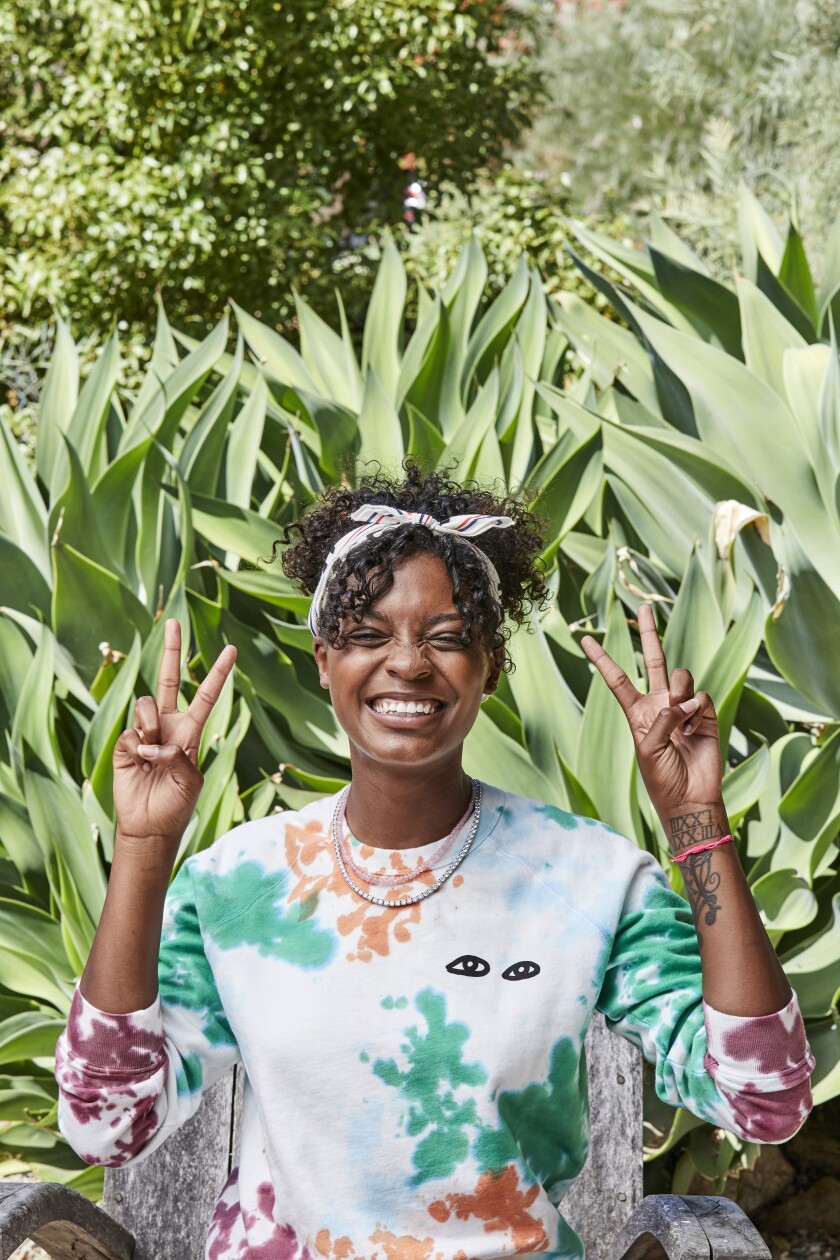
A model wears a Clare Five. White Splash tie-dye sweatshirt ($135) and a Vive La Resistance bandanna ($55). The L.A.-based designer says the pandemic has had an accelerating effect on the wearing apparel side of her concern.
(Jenna Peffley)
"COVID has made us speed upwardly like v to 10 years," Vivier said. "This is something that we'd wanted to do, but it was fast-tracked existent quick." She added that the social-distancing attribute of the pandemic has, more than generally, accelerated the wider embrace of eastward-commerce. "People who were a trivial bit shy to shop online before are definitely not shy anymore."
E-commerce wasn't an option for full-service 50.A. manicure bar Color Camp, said founder and Chief Executive Lauren Polino, who was forced to close her two SoCal salons (one in the Fairfax District and one in Studio City) when Los Angeles County's stay-at-dwelling measures went into outcome in mid-March. Notwithstanding just five weeks later, Color Camp rolled out at-home super gel manicure kits complete with paw-painted designs on reusable press-on nails selling in the $56-to-$72 range.
"I was thinking we [couldn't] practise our regular services and then let'due south come up with something for people to practise at home," said Polino, noting that the idea of augmenting her salon services with some kind of product line had been on her radar for a while. "Just it probably would have taken me at to the lowest degree six to 12 months to do the regular production development," she said.
Like many other hair and smash salons around the city, Color Army camp tried to adapt by offering its services outdoors. Although a three-24-hour interval pop-up at Platform in Culver City proved wildly pop — selling out 60 spots in two hours and generating a wait list only as long — Polino said that because of dust, sunlight and other logistical challenges, she's non keen on offer manicures al fresco.
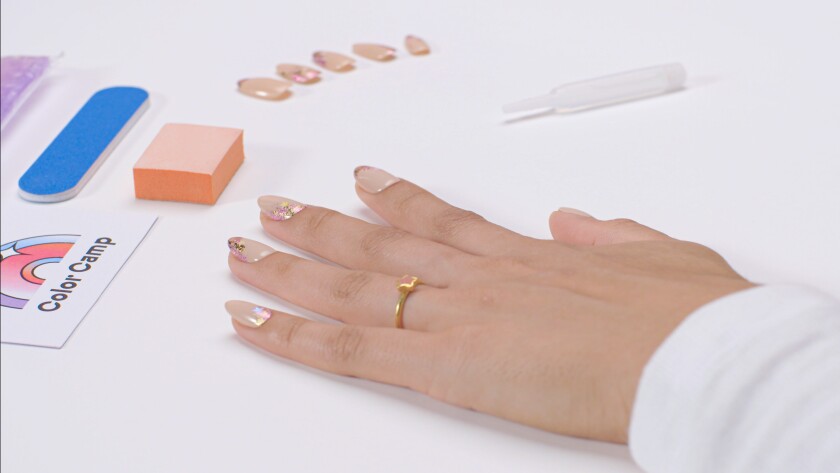
Color Military camp'southward at-dwelling house super-gel manicure kits ($56 to $72), were launched in mid-April, five weeks after its two L.A.-area salons were temporarily shuttered.
(Nathan Rea)
Equally a result of its pandemic-precipitated pivot, Color Camp has been able to keep x nail artists employed (they manus-pigment the nail fine art at home) and stay afloat (Polino said the revenue from the kits is about what one of her two salons would have generated during the same flow). And with two-thirds of the DIY gel smash kits shipping out of country (they're popular in Florida, Texas and Washington, D.C., according to Polino), the new offering had the added do good of expanding brand awareness across SoCal in a way that otherwise wouldn't have been possible.
Polino said the kits will still be on offer after Color Camp's bricks-and-mortar salons reopen for business organisation. "This is giving the states an opportunity to accomplish our audience far beyond what nosotros would take just having our salons," she said, "then nosotros're going to go on doing it."
The ascent popularity of DIY options in the beauty space makes sense given the difficulty of staying physically distant. (According to Clare Hennigan, a senior beauty annotator at market-research business firm Mintel, 50% of Americans are currently not comfortable getting in-salon beauty treatments.)
Luxury fashion has been having its own DIY moment likewise. Examples include a color-blocked JW Anderson cardigan that became the focus of a viral crocheting claiming on the mobile video platform TikTok and onetime Givenchy artistic director Clare Waight Keller showing readers of the New York Times how to make a blanket cape in that newspaper'due south Designer D.I.Y. series.
In April, when Fifty.A.-based designer Reese Cooper, a 2020 nominee for the Council of Manner Designers of America's emerging designer of the year award, offered a $98 DIY kit that included all the materials and instructions to brand an at-home version of his signature workwear-inspired glaze right downward to the patches and snap buttons, the run of ane,000 kits sold out immediately. (The jacket kits are dorsum in stock at present, along with shirt-dyeing kits and affix-your-own embroidered patches, via his label's dedicated DIY folio.)
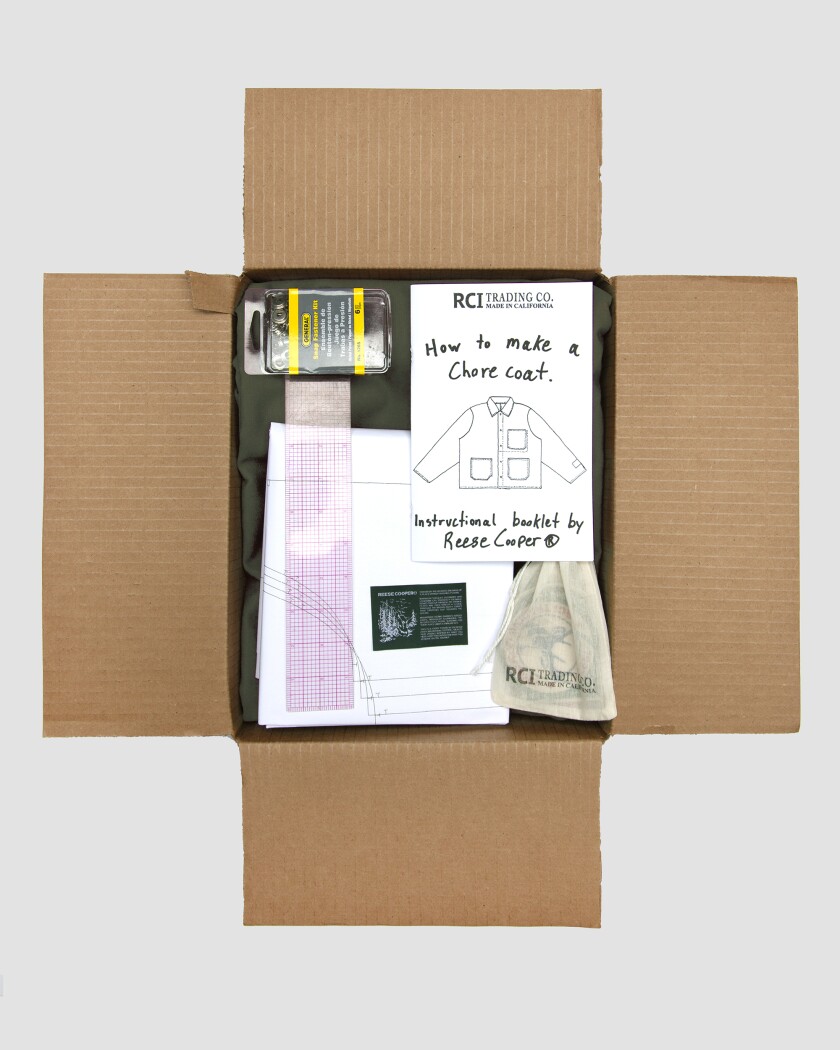
Reese Cooper says his DIY Job Coat kit ($98) has non only been popular during the pandemic, it's given him a way to continue interacting with customers online.
(Reese Cooper)
Cooper said creating the kits wasn't part of any long-term strategy only rather a way to continue — from afar — the bonding with fans and customers over DIY projects that used to take identify during the arts-and-crafts-focused open houses at his Glassell Park studio. "Information technology was really fun," Cooper said of the initial response to his DIY-in-a-box offering. "People posted pictures [on Instagram] and then I got to see a agglomeration of people — some who had never sewn before — do their thing. It was fun and information technology did well for me business organisation-wise."
The designer, whose 4-year-one-time label is all the same in growth mode, said the future that arrived ahead of schedule for him came in the form of several pocket-size, behind-the-scenes upgrades to infrastructure: things like hiring his first total-time employee (to help abound the direct-to-consumer side of the business) and relocating to a new office in downtown Los Angeles that includes a exhibit suitable for private-date shopping. "All that stuff is on the front end burner right now because I'thou home and tin really be involved," Cooper said, calculation that last yr he was averaging i aeroplane flight every 10 days. "I recollect I slept in my own bed maybe nine or ten nights a calendar month."
One of the flights Cooper didn't have this summer was to Paris, where he was set to present his jump and summer 2021 collection as part of the official Paris men's fashion calendar week calendar for the first time. He concluded up presenting his collection nearly — through YouTube's livestreaming platform — where it has been viewed more than 176,000 times in just six weeks.
"That'southward [compared to my] evidence in January, where there were only 250 people in the room," Cooper said. "I like the idea that everyone got to run across the drove at the same time. At that place was no gatekeeper. In that location was no preferential treatment. Anybody was equal."
L.A.-based menswear designer John Elliott likewise had planned to nowadays a new drove in Paris in July — a collection that, for now, remains unlaunched. (Elliott said the spring and summertime 2021 collection, titled "Where the Concrete Meets the Globe," explores the duality of metropolis and outdoor life.)
"In a weird way, I'g actually fine with that," Elliott said. "I think the way the [manner] calendar was, information technology was just then fast and so vicious. … At present I'm trying to rethink the agenda then it works improve for the brand. We exercise iv collections a year, so having the opportunity to slow downward and reassess and sharpen the sword a little chip is really refreshing."
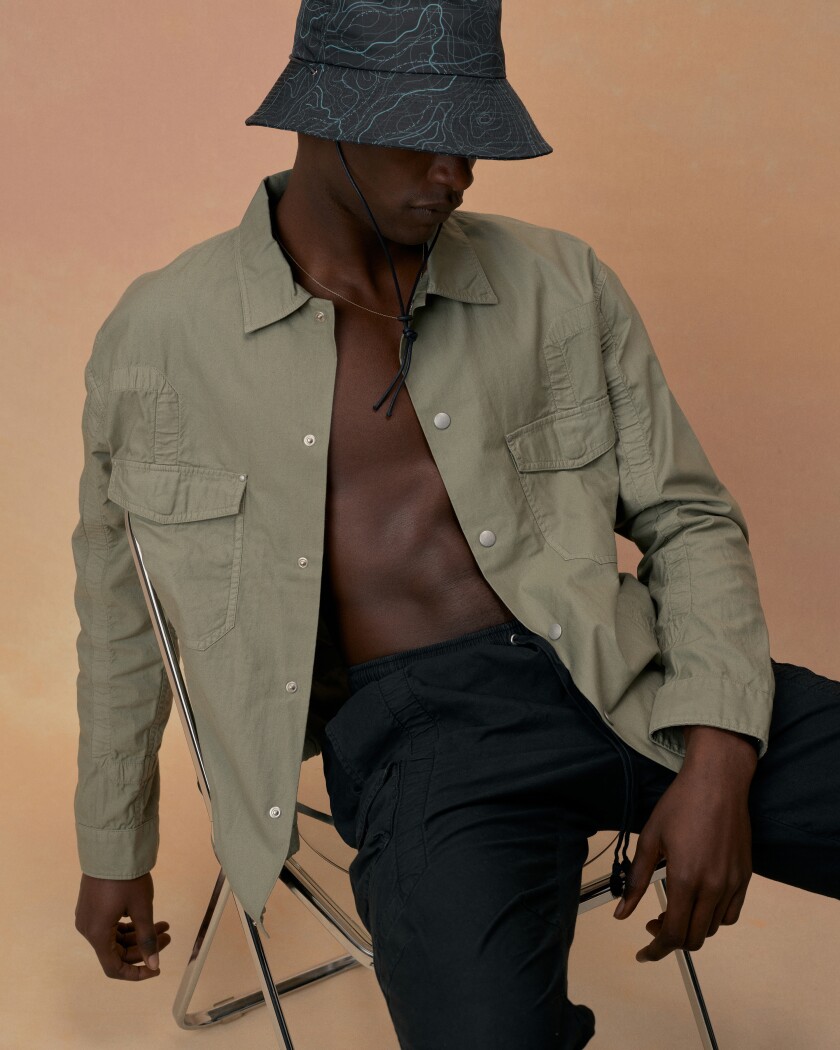
A look from John Elliott's spring and summertime 2021 menswear collection that was originally supposed to launch in July during men's fashion week in Paris but hasn't yet because of the pandemic. "In a weird way I'grand actually fine with that," Elliott says.
(John Elliott)
The hereafter of the fashion-week format has withal to come into focus. The first clue might come when a much-shortened iv-day New York Fashion Week, featuring a mix of in-person appointments and digital activations (think virtual runway shows), kicks off Sept. 13.
Elliott thinks the slowing of the hamster cycle caused by efforts to flatten the coronavirus bend could lead to long-needed, long-term, fundamental changes to the fashion-industrial complex.
"I don't know how many designers would want to acknowledge it," Elliott said, "but once y'all're on the treadmill of doing shows and launching collections, in that location's a fright that everyone has that if you jump off the treadmill, people are going to worry and say, 'Oh man, that brand is in problem.' At present, because of this, everybody has the ability to do what's best for them, and that's a beautiful thing. I think it's going to make product amend. I think it'southward going to [result in] more than artistic ways to showcase product, to launch collections and to highlight ideas. … [And] it's going to allow for production to be a trivial bit more than purposeful."
Elliott isn't alone in thinking the dark cloud of COVID-19 might take a argent lining for the futurity of fashion. "Making the Cutting" reality show winner Jonny Cota, who channeled some of his $ane meg in winnings into a futuristic and pandemic-proof revamp of his store at the Row DTLA (think virtual shop tours, cashless and touchless checkouts and many a scannable QR code), is similarly upbeat most what the style world might look similar in the future.
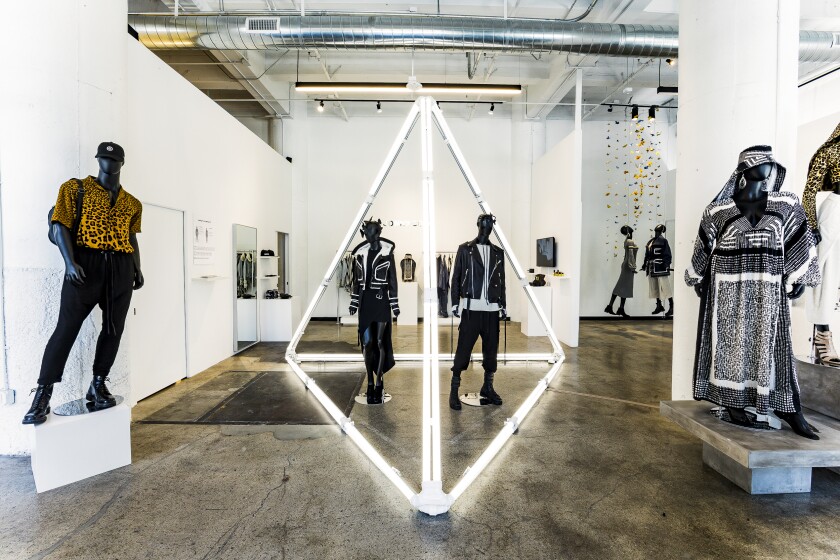
Jonny Cota's revamped shop at the Row DTLA was designed with the pandemic in listen, merely the designer thinks the changes for the style industry volition exist much more profound than contact-free checkouts and virtual shop tours.
(Michael Mendoza)
"At the risk of sounding like a total optimist, I recollect the year ahead really has limitless possibilities," Cota said. "The only abiding in this globe is change, and there hasn't been much change in the fashion manufacture in the concluding 15 years. [Now] everything'southward shifting. Major retailers are fading away. Mode week is shifting. I'm really excited almost how way designers can reimagine the fashion earth. I call back information technology's going to be smaller collections, a language that's geared more directly to our customers, and kind of redefining how we present the fantasy that is way."
If Elliott and Cota are right in their hopes that the pandemic might in some weird way turn out to be but what the hidebound way globe needs, then no matter how fast it accelerates the future can't get here soon enough.
The essential weekly guide to enjoying the outdoors in Southern California. Insider tips on the all-time of our beaches, trails, parks, deserts, forests and mountains.
You may occasionally receive promotional content from the Los Angeles Times.
Source: https://www.latimes.com/lifestyle/story/2020-09-04/covid-19-pandemic-sped-up-beauty-fashion-trends
0 Response to "Arts and Crafts Kit Trendy in the 1970s Crossword Clue"
Enregistrer un commentaire